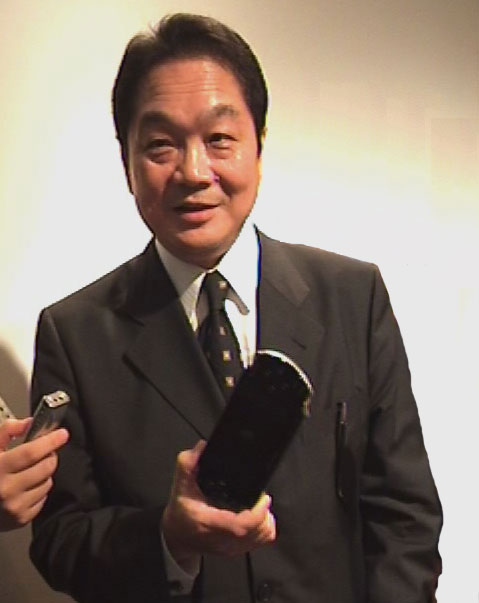Kutaragi comments on PSP pricing, prospects
SCE's outspoken president speaks out on the PSP for the first time since the price announcement this week.

TOKYO--Sony Computer Entertainment president Ken Kutaragi (shown here at a press event held earlier this month) revealed a great deal of additional information regarding the PSP in an interview with Impress Game Watch today. Kutaragi covered a range of topics, including price, cost of goods, and battery life.
On Wednesday, Sony announced that the system would release on December 12 in Japan at an MSRP of 19,800 yen ($185). Up until the announcement, analysts in Japan and around the world were expecting that the PSP would be priced around the 25,000 yen ($235) range. Any price above that would have given the Nintendo DS, which is set to be released on December 2 in Japan, a price advantage of more than 10,000 yen ($95).
“As with the PlayStation and PlayStation 2, the PSP's price wasn’t decided until the very last moment,“ said Kutaragi. “The price was kept a secret even to the company. I didn’t even reveal it to my wife. And, so, there were actually surprised people inside of Sony.”
200,000 PSP units will be shipped on launch day in Japan, with an additional 300,000 units promised before the end of the year. As Sony's annual manufacturing rate is about 3 million PSP units, the company, for the next fiscal year, will ship 1 million units each to North America, Europe, and Japan. That, says Kutaragi, will be the break-even point for Sony's PSP to start making a profit. (By comparison, Nintendo plans to ship 4 million units of the DS worldwide in the next five months.)
Kutaragi asserted that the main reason why Sony was able to price the PSP below any analyst's speculations is because 50 percent of the components used inside the handheld are produced internally. In particular, said Kutaragi, Sony will be able to massively cut costs by manufacturing the PSP's 90nm CPU at its own fabrication labs.
"People from various sectors were saying that [the establishment of] 90nm fabrication labs would be reckless. But the pricing of the PSP wouldn't have been possible if we were to outsource its chips," he said. "Our 90nm fabrication labs will all be working at full capacity for the PSP, the new model of the PlayStation 2, and other chips needed by the Sony group. And if it weren't for the investment [in the factories], the PSP’s low price wouldn't have been possible."
When planning for the PS2, Sony aimed to make a profit on the long term while gradually dropping the console's price. But for the PSP, the company hopes to start turning a profit in the short term by releasing the handheld at a low starting price on its launch day.
Thus, said Kutaragi, it is essential that the handheld expands into the market as quickly as possible so that it will have a large library of games at an early stage. That, in return, will raise the demand for the PSP and make it possible for Sony to order the components that are outsourced--such as the liquid display panels from Sharp--in large volumes, which will cut manufacturing costs even more.
Kutaragi also revealed that other sectors in the Sony group are looking forward to the PSP and are hoping to expand on the handheld's functions, although whether this will happen is still up in the air. One of the examples given by Kutaragi was an idea suggested by Sony's broadband sector, whereby PSP users would be able to connect to their TV sets at home, via online connection, so they could watch live shows and taped recordings over the PSP's screen.
Finally, Kutaragi touched on the PSP's rechargeable battery, which is purported to last between four to six hours--on average--for games, and up to four to five hours for movies.
"The battery consumption changes depending on the memory and processor usage, aside from disk access," he said. "It'll run for a long time when playing puzzle games but shorter when playing Ridge Racer, for example. Using the wireless LAN also affects the battery consumption […] I think that there's still some room left for power-consumption improvement through software."
"In the future, we’re hoping that the PSP can last without a recharge [during a full flight] between Narita [Tokyo International Airport] and New York," said Kutaragi. He then added, “The Walkman only ran for about two hours when it first came out, too.”
Got a news tip or want to contact us directly? Email news@gamespot.com
Join the conversation